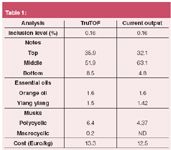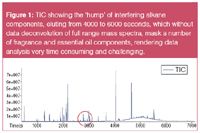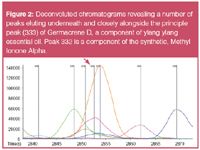Unravelling the Complexity of Fragrances in HPC* Products Using TruTOF GC–TOF-MS with Automated Data Deconvolution
The Application Notebook
The composition and analysis of fragrance components in home and personal care (HPC) products is very complex and unquestionably time consuming.
Nick Jones,1 Marcel Kneepkens,1 Izabela Malyszko,1 Sjaak de Koning2 and Lorraine Kay,2
1 Global Fragrance Centre, Unilever Research and Development, Port Sunlight, UK,
2 LECO European Technical Centre (ETC), Separation Science, Mönchengladbach, Germany.
Introduction
The composition and analysis of fragrance components in home and personal care (HPC) products is very complex and unquestionably time consuming.
Traditionally, significant GC–MS time may be consumed by running multiple separations using different phases. The resulting chromatograms are subject to labour intensive data interpretation, using retention index and mass spectral libraries, to accurately resolve and quantify the composition of perfume raw materials, including essential oils in the products.
Now, a new analytical approach has been evaluated. Using a LECO TruTOF GC–TOF-MS, with automated true signal data deconvolution, it is possible to significantly increase the throughput of such analyses using single separations. Additionally, in some cases where either there are a lot of interferences from the matrix or a complex mixture of essential oils, the ability to deconvolute full range mass spectra provides extra information. This will also increase our ability to accurately characterize and interpret our data to further unravel the complexity of fragrances in such products.
A skin care lotion, containing a relatively complex perfume including a number of essential oils was chosen to assess the ability of LECO TruTOF GC–TOF-MS. The goal was to increase both the throughput and quality of output, compared to the conventional multi-run analysis approach described. The skin care lotion analysed, was particularly appropriate, because of the presence of a high level of alkane (petroleum jelly) components. Such materials are significant interferences in fragrance analysis, as a result of their similarity in polarity and volatility to a high number of middle and base note perfume components.
Sample Selection and Introduction
A solvent extraction and proprietary clean-up procedure was used to extract perfume components from the skin lotion. Internal standards were added prior to the extraction/clean-up process for quantification purposes. The resulting sample was then concentrated by Vigreux distillation for analysis. Analysis of the sample was then performed by the traditional multi-phase/run approach described, using single quadrupole GC–MS systems, as well as by a single separation using a LECO TruTOF GC–TOF-MS system.
Results
Analysis of data collected using the existing 2-separation, single quadrupole MS measurements, processed manually, was compared to data collected from a single sample injection and separation using the TruTOF GC–TOF-MS system. This data was automatically deconvoluted using LECO's ChromaTOF software and incorporated Unilever R&D, Global Fragrance Centre mass spectral fragrance libraries.

Table 1
The output of the TruTOF analysis was compared to that of the standard, more time consuming fragrance analysis, which as a fully validated and well used procedure, provides an excellent benchmark. Key outputs from the analysis of fragrances in HPC products are inclusion levels, top, middle and base notes, essential oils, musks and approximate costs (as shown in Table 1). Therefore, measures of these were chosen for the comparison. The single injection TruTOF approach compared very favourably with the standard approach. In addition to this, a number of additional musk and essential oil components were identified underneath the 'hump' of alkane interferences.

Figure 1
The TIC trace in Figure 1 does not lend itself to easy interpretation. However, Figure 2 shows a zoom of the mass traces that are hidden under the TIC and seen following the automated deconvolution data processing methods. The deconvoluted chromatograms also reveal a number of peaks eluting underneath and closely alongside the principle peak (333) of Germacrene D, a component of ylang ylang essential oil. Peak 332 is a component of the synthetic, methyl ionone alpha and is represented by the pink mass trace below.

Figure 2
Conclusion
This study suggests that the use of a LECO TruTOF GC–TOF-MS system coupled with ChromaTOF deconvolution software, may provide an accurate and higher throughput alternative to other, multi-phase, multi-run separations that require significantly more resources, both in terms of man hours for data analysis and instrument operation time.

In addition, the ability to maintain full sensitivity over the full mass range and the ability to collect spectra at up to 80 spectra/second, yielding effective data deconvolution, may enable a richer and more informative data set and, to a great extent, eliminate the risk of losing important information during the analysis of HPC products that contain a high level of interferences, such as the skin lotion analysed here.

LECO European Technical Centre (ETC)
Marie-Bernays-Ring 31, 41199 Mönchengladbach, Germany
tel. +49 2166 687 104 or 107 fax +49 2166 687 148
E-mail: SepSci@leco.de
Website: www.leco.com

Robust Oligonucleotide Molecular Weight Confirmation via LC/MS
October 31st 2024Oligonucleotides—therapeutic agents for difficult-to-treat diseases—rely on precise molecular weight confirmation to ensure quality during development. Experts from Agilent Technologies explore the challenges of liquid chromatography-mass spectrometry (LC/MS) analysis in oligonucleotide synthesis, as well as strategies for accurate deconvolution, method development, and optimal equipment selection.
Development of a Fully Scalable High Efficiency 5um Solid-Core Particle to Support HPLC Workflows
October 30th 2024In this work the development of two key attributes of the 5um CORTECS Columns is examined. First column efficiency is compared across CORTECS and other solid-core 5 μm columns. Next scalability from sub-2 μm to 5 μm particles is examined between the CORTECS Column lines and competitive column lines. It was found that CORTECS columns have higher efficiency compared to other solid-core columns and that CORTECS particles are fully scalable.